#City Development
Explore tagged Tumblr posts
Text
So i'm working on a project that involves looking at people's opinions on public transportation, and something that keeps coming up is that a lot of people like the idea of public transportation but ridership is at the same time low, so I wanna figure out what stops people from riding.
If you could reblog this for bigger sample size that would be so so appreciated
#public transportation#city development#urban design#walkable cities#public transit#busses#trains#streetcars#metro#subway#poll#civic engagement#research#academia#opinions
7K notes
·
View notes
Text
Urban Renewal vs. Public Housing: Lessons from Baltimore and Pruitt-Igoe
Urban renewal and public housing have played a central role in shaping American cities, often with conflicting results. While urban renewal aims to modernize and revitalize decaying cityscapes, it frequently displaces long-standing communities, exacerbating socioeconomic inequalities. Conversely, public housing has been used to provide affordable homes for low-income populations, yet poor planning and neglect have led to segregation, poverty concentration, and failure.
This article explores these urban planning challenges through two significant case studies: Baltimore’s Inner Harbor renewal project and the Pruitt-Igoe public housing complex in St. Louis. These examples reveal the successes and failures of 20th-century urban planning, offering critical lessons for the future of equitable city development.
The Case for Urban Renewal: Baltimore’s Inner Harbor
In the mid-to-late 20th century, Baltimore launched one of the most ambitious urban renewal projects in the U.S., aimed at revitalizing its deteriorating downtown and waterfront areas. The redevelopment of Charles Center and the Inner Harbor sought to attract businesses, tourists, and high-income residents back into the urban core.
✅ Economic Growth & Tourism Boost:
The Inner Harbor was transformed into a vibrant commercial and cultural hub, with attractions like the National Aquarium and Maryland Science Center.
New retail, office spaces, and residential developments increased property values and business investments.
✅ Mixed-Use Development & Walkability:
The project embraced modern urban design principles, making the Inner Harbor a 24-hour activity zone instead of a purely business district.
The redevelopment created public spaces, waterfront promenades, and green areas, making the area more livable and attractive.
However, despite these successes, Baltimore’s renewal came with a price—one paid disproportionately by lower-income residents.
📉 Displacement & Gentrification:
The rising cost of living forced many working-class and minority residents out of the area.
Long-standing communities were pushed to the city's margins, leading to increased inequality and social tensions.
📉 Who Really Benefited?
Many of the jobs created by urban renewal did not go to local residents but rather to suburban commuters and outside investors.
The benefits were concentrated in wealthier, predominantly White areas, deepening racial and economic disparities.
Lesson: Urban renewal can drive economic growth, but without equitable policies, it risks displacing the very communities it aims to uplift. Sustainable urban planning should incorporate affordable housing, job creation, and community input to ensure benefits reach all residents.
The Failure of Public Housing: St. Louis’ Pruitt-Igoe Disaster
While Baltimore’s renewal focused on economic revitalization, St. Louis’ Pruitt-Igoe public housing complex is a cautionary tale of poorly executed housing policies. Built in the 1950s, Pruitt-Igoe was meant to be a modern, affordable housing solution for low-income residents. However, within two decades, it became one of the most infamous failures of public housing in America.
📉 Economic & Social Isolation:
As St. Louis lost manufacturing jobs and white flight accelerated suburbanization, Pruitt-Igoe’s predominantly Black residents faced growing unemployment and poverty.
Many residents struggled to afford rent, leading to funding shortages for maintenance and services.
📉 Poor Urban Design & Maintenance Neglect:
The "towers in the park" design created isolated, unsafe spaces that became hotspots for crime.
Elevator breakdowns, vandalism, and lack of maintenance made the complex nearly uninhabitable.
📉 Demolition: The End of an Era
By the late 1960s, Pruitt-Igoe had become a symbol of public housing failure.
In 1972, just two decades after its construction, the federal government demolished the entire complex—a moment often regarded as the death of high-rise public housing projects in the U.S.
Lesson: Public housing cannot succeed without long-term economic investment, proper maintenance, and integration into the broader urban fabric. Instead of isolating low-income populations in concentrated developments, policies should prioritize mixed-income housing, economic support, and community services.
Urban Planning Lessons for the Future
The contrasting stories of Baltimore and Pruitt-Igoe illustrate the complex challenges of urban development. Both cases emphasize the need for urban planning approaches that balance economic development with social equity.
✅ Urban Renewal Should Include Community-Driven Growth
Economic development should not come at the cost of displacing vulnerable communities.
Cities must include affordable housing policies, local hiring initiatives, and resident engagement in renewal projects.
✅ Public Housing Must Be Integrated, Not Isolated
Instead of large, isolated housing blocks, urban planners should invest in mixed-income, mixed-use developments that connect residents to jobs and services.
Public housing policies should prioritize maintenance and long-term sustainability rather than quick-fix solutions.
✅ Equitable Urban Planning Requires Thoughtful Policy
Planners and policymakers must address historical inequities in housing and economic access.
Transit, education, and workforce development programs should accompany any large-scale urban redevelopment effort.
Conclusion: Rethinking Urban Development for the 21st Century
Urban renewal and public housing remain central to urban development debates today. Baltimore’s Inner Harbor shows the power of economic revitalization—but also its risks of gentrification and exclusion. Pruitt-Igoe, on the other hand, serves as a lesson in the failure of isolated, underfunded public housing projects.
For cities to create sustainable, inclusive growth, planners must move beyond outdated models and embrace community-centered, equitable policies that ensure all residents benefit from urban progress.
#smart growth#pruittlgoe#public housing#community development#housing inequality#gentrification#baltimore#city development#economic development#gis#portfolio#strong towns#urban planning#sundusbhatti
12 notes
·
View notes
Text
The Magic of Street-Side Trees. Beauty, Coolness, and Urban Prosperity.
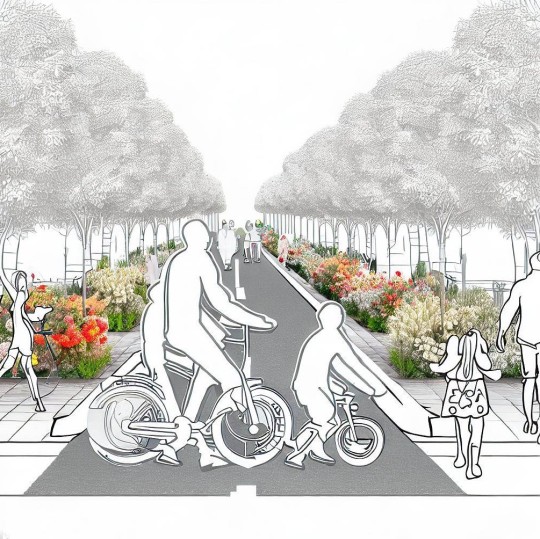
The beauty, coolness, and urban prosperity brought by street-side trees.
Trees lining urban streets are integral elements of the urban landscape, serving multiple ecological roles and socio-economic functions. In general, incorporating trees along the roads in urban areas can elevate the aesthetic appeal, regulate temperatures, and foster prosperity growth. And if our goal is to enhance the role of cities in driving economic growth and fully utilizing human resources, then we must prioritize making tangible improvements to urban environments.

Trees are crucial components for creating appealing and hospitable urban environments that enhance citizens' psychological and social well-being. They play a vital role in reducing air temperature and humidity, which helps alleviate the effects of heat waves and global warming. Trees bear witness to the history, culture, and identity of cities, which they preserve and pass on to future generations. In addition to their undeniable beauty, trees are valuable allies in the fight against climate change.
They provide a range of local benefits that are often ignored beyond the global role of absorbing carbon dioxide. This article aims to increase awareness among readers about the importance of trees for cities and the planet. It seeks to motivate all of us to value, preserve, and protect the urban tree heritage through a participatory and accountable manner that involves citizens and institutions.
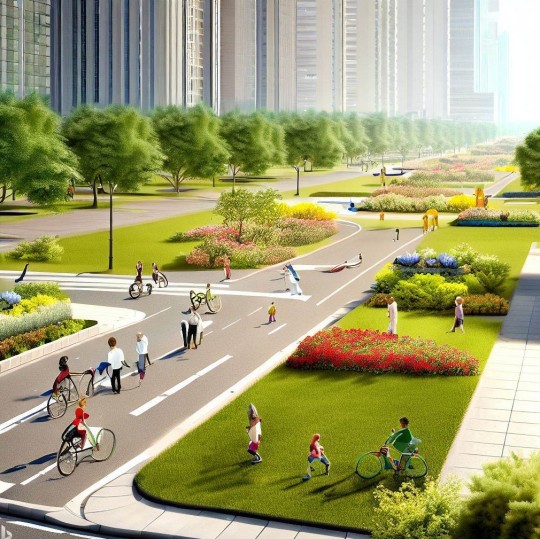
Street-side trees are more than just beautiful to look at. They are an essential resource for cities, providing numerous benefits to residents' health, well-being, and quality of life. In their article on Monocolo, Paolo Massi and Giulia Papaleo highlight the main advantages of trees in urban areas. La magia degli alberi lungo le strade. Bellezza, frescura e prosperità urbana
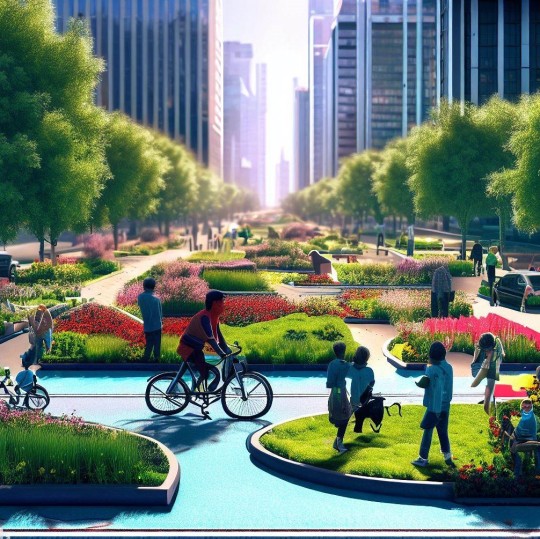
Among the benefits that trees bring to the urban environment, we can mention:
Trees perform ecological, social, and economic functions that contribute to the well-being and development of cities. They help to reduce air pollution by capturing particles, filtering harmful gases, and producing oxygen. Trees also absorb carbon from the atmosphere and store it in their wood, making them beneficial for climate change mitigation. Additionally, trees create shade, cool the air, and reduce energy consumption for cooling buildings. They prevent flooding, improve water quality, and increase biodiversity by providing shelter and food for many species. Trees enhance the urban landscape, mitigate noise, and even increase the value of properties.
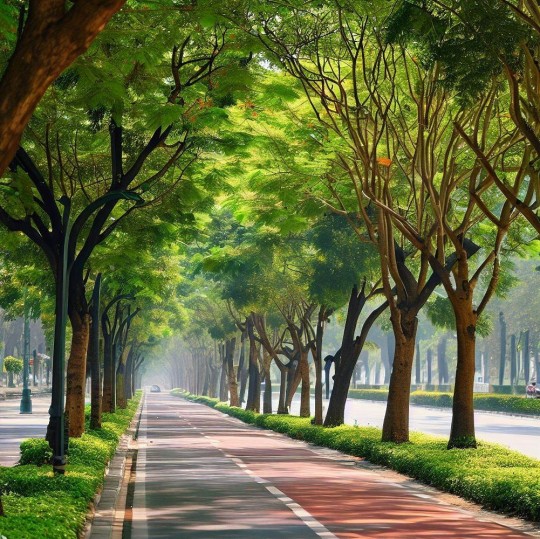
Moreover, they promote physical and mental health by stimulating physical activity, reducing stress, and improving mood and concentration.
Therefore, roadside trees are a valuable resource for cities and their inhabitants. It is critical to protect, care for, and increase them through various means, such as public policies, private actions, and guaranteed maintenance over time, recognizing their fundamental role in the quality of urban life so that maintenance, which develops jobs, in particular, is 'guaranteed' over time,

Urban forestation and eco-neighborhoods.
Urban forestation refers to designing and creating green spaces in urban and peri-urban areas to incorporate nature into the landscape. It is important to both develop new green spaces and enhance existing ones.
Eco-neighborhoods serve as an example of sustainable and livable urban environments. They are designed considering the environment and the health of their residents. Sustainability principles are followed to improve the landscape and economic assets of the urban context. The design of an environmentally sustainable neighborhood aims to reduce its environmental impact during construction, throughout its life cycle, and even during decommissioning while prioritizing the comfort of its residents. These neighborhoods are built to improve people's quality of life by emphasizing energy conservation, renewable energy, environmentally friendly materials, reducing water and waste consumption, and promoting sustainable mobility. They are tangible parts of the city that contribute to the well-being of its inhabitants.
In addition, urban forestation is another example of how urban environments can be made more livable and sustainable. We can seamlessly blend nature into the urban landscape by integrating street trees, gardens, and parks. They represent elements of nature that help purify the air we breathe, capturing pollutants, storing carbon, and mitigating the climate of cities.
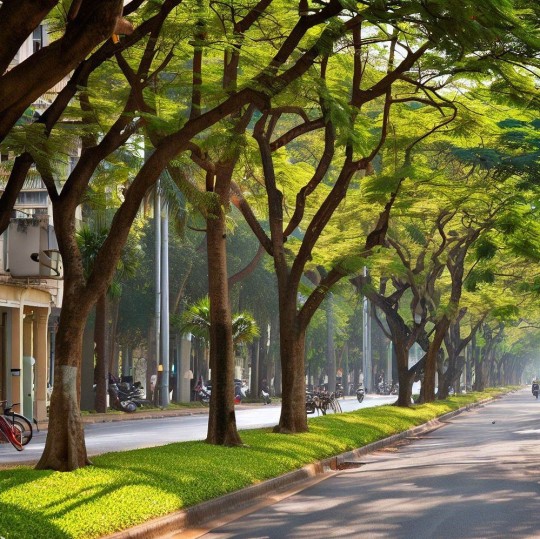
In summary, street-side trees are not just a decorative element but a proper green infrastructure that improves the quality of urban life. Therefore, It is vital to encourage planting, caring for, and preserving trees in urban areas, with the participation of government institutions, businesses, and residents, in order to achieve a shared vision to promote sustainable progress.
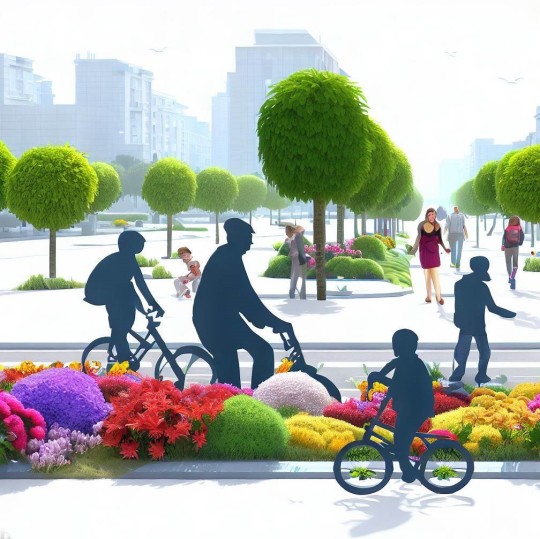
🟠 Italiano
Intro
Gli alberi sono elementi essenziali per creare paesaggi urbani attraenti e accoglienti, che favoriscono il benessere psicologico e sociale dei cittadini. contribuiscono a ridurre la temperatura e l'umidità dell'aria, mitigando gli effetti delle ondate di calore e del riscaldamento globale. Essi sono testimoni della storia, della cultura e dell'identità delle città, che conservano e trasmettono alle generazioni future. Alleati nella lotta ai cambiamenti climatici, oltre alla loro innegabile bellezza offrono una serie di benefici locali che spesso tendiamo a trascurare (al di là dei benefici globali di assorbimento dell’anidride carbonica). Questo articolo quindi ha lo scopo di sensibilizzare i lettori sull'importanza degli alberi per le città e per il pianeta, invitandoli a conoscere, apprezzare e tutelare il patrimonio arboreo urbano coinvolgendo i cittadini e le istituzioni in un processo partecipativo e responsabile.
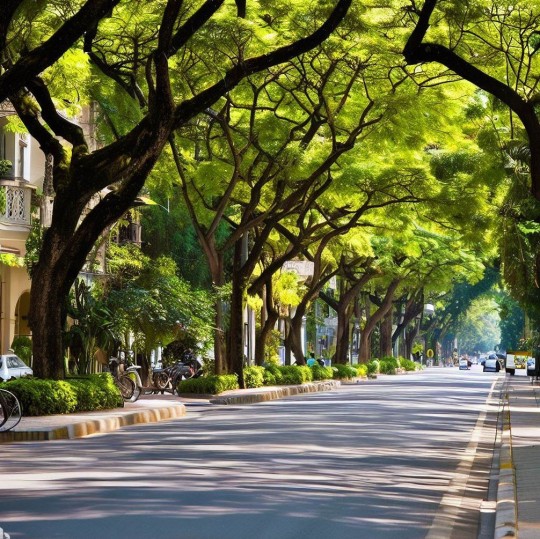
La magia degli alberi lungo le strade. Bellezza, frescura e prosperità urbana.
Gli alberi sono una risorsa preziosa per le città, non solo per il loro contributo alla mitigazione dei cambiamenti climatici, ma anche per i molteplici benefici che apportano alla salute, al benessere e alla qualità della vita dei cittadini. In questo articolo del Monocolo gli autori Paolo Massi e Giulia Papaleo, vogliono illustrare alcuni dei principali vantaggi che gli alberi offrono alle aree urbane e alle persone che le abitano. La magia degli alberi lungo le strade. Bellezza, frescura e prosperità urbana
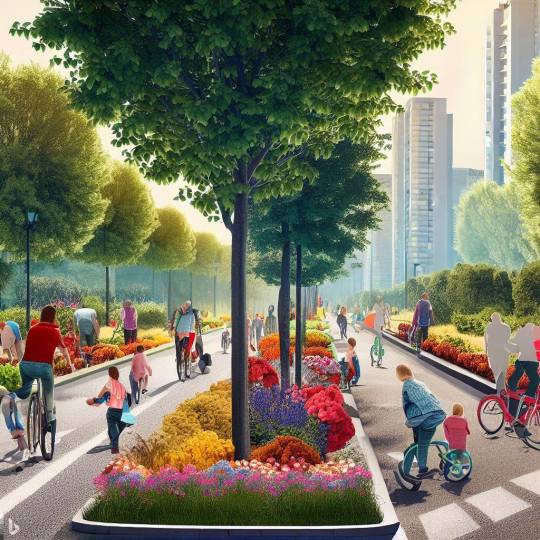
La magia degli alberi lungo le strade dunque non si limita alla loro estetica. Gli alberi sono elementi essenziali per il benessere e lo sviluppo delle città, in quanto svolgono funzioni ecologiche, sociali ed economiche. Tra i vantaggi che gli alberi apportano all'ambiente urbano, possiamo citare:
Riduzione dell'inquinamento atmosferico: gli alberi catturano le particelle sospese nell'aria, filtrano i gas nocivi e producono ossigeno.
Mitigazione del cambiamento climatico: gli alberi assorbono il carbonio dall'atmosfera e lo immagazzinano nel loro legno, contribuendo a ridurre l'effetto serra.
Regolazione termica: gli alberi creano ombra e rinfrescano l'aria attraverso la traspirazione, diminuendo la temperatura e il consumo energetico per il raffreddamento degli edifici.
Conservazione del suolo e dell'acqua: gli alberi riducono l'erosione del suolo, aumentano la sua capacità di infiltrazione e ritardano il deflusso delle acque piovane, prevenendo le inondazioni e migliorando la qualità dell'acqua.
Incremento della biodiversità: gli alberi offrono rifugio e cibo a molte specie animali e vegetali, arricchendo la diversità biologica delle città.
Valorizzazione del paesaggio urbano: gli alberi creano scenari naturali, armonizzano l'architettura, attenuano il rumore e aumentano il valore immobiliare delle proprietà.
Promozione della salute e del benessere umano: gli alberi favoriscono la salute fisica e mentale delle persone, stimolando l'attività fisica, riducendo lo stress, migliorando l'umore e la concentrazione.
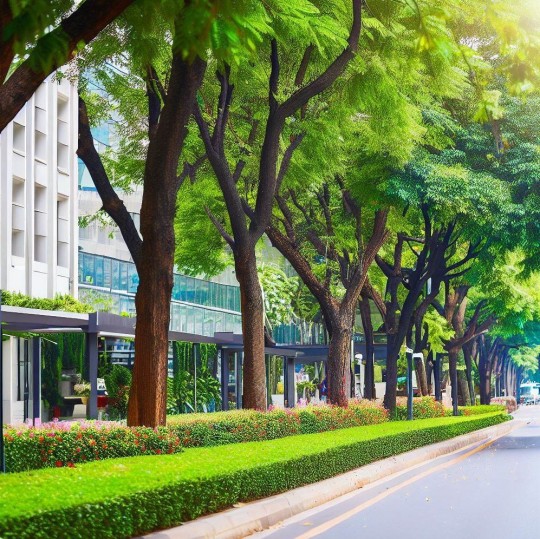
Gli alberi e le aiuole a verde lungo le strade sono quindi una risorsa preziosa per le città e i loro abitanti. Per questo motivo, è importante proteggerli, curarli e incrementarli, attraverso politiche pubbliche e azioni private che ne riconoscano il ruolo fondamentale per la qualità della vita urbana affinché la manutenzione, che sviluppa posti di lavoro, in particolare venga 'garantita' nel tempo.
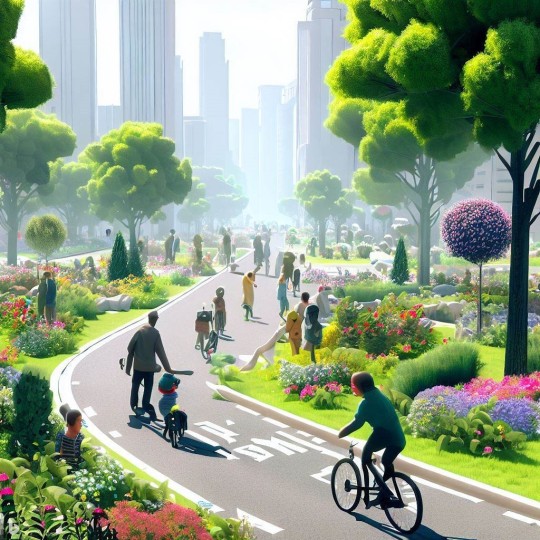
La forestazione urbana e gli ecoquartieri
Con il termine forestazione urbana si intende la progettazione e lo sviluppo di aree verdi urbane e periurbane, facendo della natura un'importante protagonista di questo paesaggio. Chiaramente è importante non solo progettare e sviluppare nuove aree verdi, ma anche rivalorizzare e riappropriarsi di quelle esistenti.
Certo! Gli ecoquartieri sono un esempio di ambienti urbani sostenibili e vivibili. Sono quartieri costruiti nel rispetto dell’equilibrio ambientale e della salute delle persone che vi abitano. Sono conformi ai principi della sostenibilità e puntano alla valorizzazione del patrimonio paesaggistico ed economico del contesto urbano in cui sono inseriti. La progettazione di un quartiere ecosostenibile punta a ridurne l’impatto ambientale: dalla fase di costruzione, al ciclo di vita, fino alla sua dismissione, senza mai dimenticare il comfort di chi lo vive. Si tratta di vere e proprie porzioni di città edificate con l’obiettivo di innalzare il livello di qualità della vita e sono realizzate ponendo l’accento su: risparmio energetico; uso delle energie rinnovabili e di materiale ecologico; riduzione del consumo di acqua e di rifiuti; promozione della mobilità sostenibile.
Inoltre, la forestazione urbana è un altro esempio di come gli ambienti urbani possono essere resi più vivibili e sostenibili. Le alberature stradali, i giardini e i parchi urbani rappresentano degli elementi di natura che contribuiscono a purificare l’aria che respiriamo, catturando sostanze inquinanti, immagazzinando carbonio e mitigando il clima delle città.
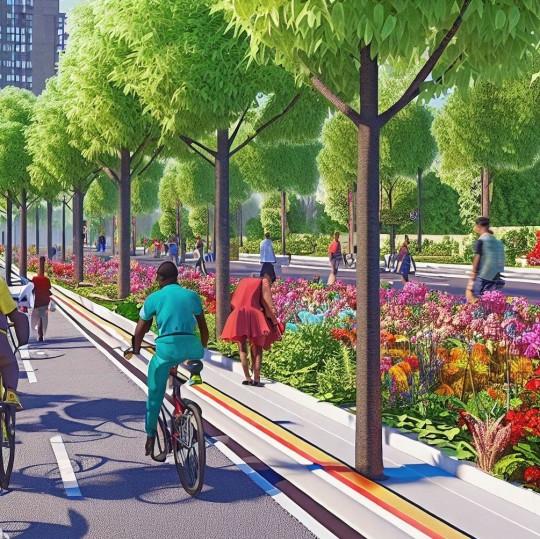
Come si può notare, gli alberi lungo le strade non sono solo un elemento decorativo, ma una vera e propria infrastruttura verde che migliora la qualità della vita urbana. Per questo motivo, è importante promuovere la piantumazione, la manutenzione e la protezione degli alberi nelle città, coinvolgendo le amministrazioni pubbliche, le imprese e i cittadini in una visione condivisa di sviluppo sostenibile.
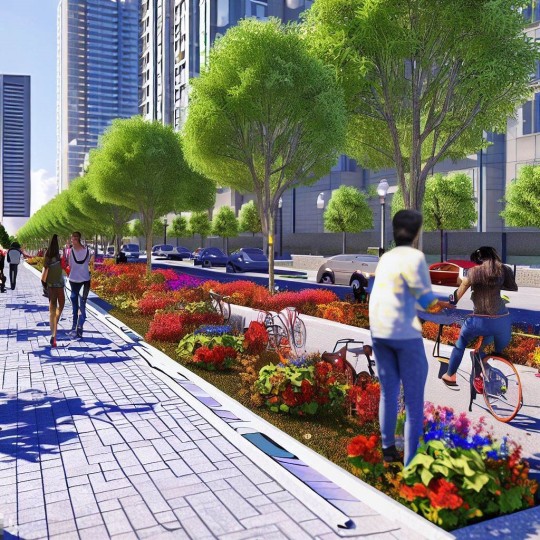
images created by The Board Behind © 2023
More related topics on this matter you might like:
Landscape Architecture: self-reflection on improving and enhancing our cities' run-down suburbs. English /Italian
Give color to the city to celebrate the joy of living.
I appreciate your kind presence and attention on this matter. Thank you for joining us today.
⏩ The Board Behind
#the board behind#sviluppo sostenibile#urban environments#urban tree heritage#ecological restoration#social growth#economic growth#city development#well being#urban living#urban life#heat wave#heat islands#sustainable progress#social innovation
15 notes
·
View notes
Text
@luulapants
this is so funny
"but uh when we advocated for indigenous sovereignty we thought you guys were just going to make a big park or something"
"fuck you. ultradense housing that bypasses your stupid zoning rules"
17K notes
·
View notes
Text
Ex Novo by Martin Nerurkar & Konstantinos Dimopoulos
I picked a copy of this (and Quill) up from DriveThruRPG last year and read it this month (six months later - that's actually pretty fast for something on my to-read list...) I grabbed it because I have a few writing ideas that would benefit from having a map of a city at least roughed out and I am not a cartographer. Having prompts and a process to walk through sounded good to me.
From the front cover:
a city-building game to generate playable settlements for use in other creative endeavors. Designed for 1 to 4 players with a playtime of about 2 hours. Created by Martin Nerurkar and Konstantinos Dimopoulos.
It's a short pdf, just 47 pages total. Most of those are for the tables in the back you roll on for major events happening in the city. Each encourages you to think about how the event affects the city and how that gets reflected on the map you're drawing. The directions for stepping through the history of the city are clear and concise (which I always appreciate). Honestly, I think I'm going to understand the whole game better once I play it — there was only so much of the idea I was getting from just reading the rules. But my impression is that it's slightly more a builder of a city's history than a builder of a city's map. This isn't a bad thing, just maybe not precisely what I was looking for. Then again, a city's history is extremely influential on how a city develops and therefore what the map will look like. I think maybe I was looking for a 'this is how you put together some coherent geography and that how it affects a city,' which I did not know until I read this game. Again, I think I will get a better understanding when I carve out two hours with a friend or my Partner and play through the game. I hope so anyway.
Based just on reading it, I give it a 3.5 out of 5. I would have liked more about building the geography of a city, in addition to building a city's history.
2025 Reading Goal: 6/20
#book#books#book review#ttrpg#indie ttrpg#indie games#maps#cities#city#city development#map building#solo game#1-4 players
1 note
·
View note
Text
youtube
0 notes
Text
Legends Among Us: Celebrating Canada's Storied Past
Join us to celebrate Canada History Week from November 18 to November 24, 2024 Canada History Week, celebrated from November 18 to November 24, 2024, provides Canadians with a chance to delve into the rich tapestry of their nation’s past. This commemorative week encourages reflection on the people, places, and events that have shaped Canada’s identity. Explore, Learn, Remember: Canada History…

View On WordPress
#BeLikeBruce Campaign#Benjamin Thomas Chappell#Beyond Borders#Beyond Medals#Bruce Gordon#Building Our Future#Building Our History#Building Tomorrow#Canada History Week#Canada&039;s Diverse Threads#Canada&039;s Historical Icons#Canada&039;s Historical Threads#Canada&039;s Icons#Canada&039;s Inspirations#Canada&039;s Journey#Canada&039;s Remarkable History#Canada&039;s Treasures#Canadian Chronicles#Canadian Legacy#Canadian Narratives#Canadian National Railways#Canadian Pioneers#Chronicles in Focus#Chronicles of Courage#City Building Legacy#City Building Stories#City Development#Connecting with Legacy#Cultural Reflection#cultural richness
0 notes
Text
Meet Sarasota’s new urbanists, the Sarasota Mobility Alliance
Young, determined and willing to make a change, Colby Heidke realized that if Sarasota’s transportation was to be more accessible to its residents, the community was going to have to do it themselves. Heidke and New College thesis student Chai Leffler founded the Sarasota (SRQ) Mobility Alliance in February, after finding a shared interest in urban planning and accessibility. Since then, they…

View On WordPress
#city development#city infrastructure#city planning#sarasota city planning#sarasota infrastructure#sarasota mobility alliance#sarasota urbanism#SRQ mobility alliance#srq urbanism#urbanism#walkable cities
0 notes
Text
Resilient cities as a driving force of economic development and fighing inequalities - 2nd Azerbaijan National Urban Forum.

The 2nd Azerbaijan National Urban Forum is organized by the government of Azerbaijan in collaboration with UN-Habitat. It is preceding World Habitat Day. It will take place in the cities of Zangilan and Baku, from 29 September - 1 October 2023.
AZERBAIJAN NATIONAL URBAN FORUM.
Urban planning and city development play a crucial role in driving progress towards achieving sustainable development. Given the ongoing global urbanization trends, the significance of these development agenda items is further reinforced by specific challenges and opportunities faced by each country. The Republic of Azerbaijan represents one of such countries. As it actively supports and promotes the localization of the 2030 Sustainable Development Agenda, Sustainable Development Goal (SDG) 11 is considered a vital component of the country's post-conflict socio-economic reintegration priorities. The New Urban Agenda, offering an action-oriented universal framework for sustainable housing, holds great value in this regard. Collaboration, experience-sharing, and learning from each other are essential for the success of national and sub-regional sustainable development efforts.
To highlight the importance of sustainable urbanization processes, the Government of the Republic of Azerbaijan, in collaboration with UN-Habitat, will organize the 2023 Urban Week. The Urban Week will commence with the 2nd Azerbaijan National Urban Forum (NUFA2) on 29 September 2023. NUFA2 will bring together a diverse range of urban stakeholders and participants, both from Azerbaijan and internationally, over three days. The forum will be held in the cities of Zangilan and Baku. While NUFA2 aims to discuss emerging key urban challenges, ongoing projects and the vision for the urban future in the Republic of Azerbaijan, it will also show-case international experiences in the related field to stimulate local action. Given the global importance of post-conflict reconstruction and rehabilitation, NUFA2 will be focusing on the role of urban productivity and economic growth, hereby fully deploying the potential of the SDGs and the NUA for economic resilience and transition to a circular economy. Urban week will continue with World Habitat Day, which will be held on October 2 in Baku.
The event will bring together a diverse range of national and international urban stakeholders. The forum will address key emerging urban challenges and showcase international experience focusing on the role of urban productivity and economic growth, hereby fully deploying the potential of the SDGs and the New Urban Agenda for economic resilience and transition to a more sustainable urban future.
#Resilient cities#economic development#social development#environmental development#urban development#urban environment#urban stakeholders#forum#urban productivity#un-habitat#Urban planning#City development#sustainable urban development#Azerbaijan
0 notes
Text

joining sofia in my last post is the vox pha fantasma himself!
#dropout#dimension 20#d20#d20 the unsleeping city#the unsleeping city#pete conlan#huge fan of his character development#do miss the cowboy hat a little
895 notes
·
View notes
Text
Smitten with Siem Reap — What an Amazing World!
Walking in Siem Reap at night The Defeat of Siam. Quite a name for a place situated not too far from the border with Siam – modern-day Thailand – itself. Imagine if there was a city in France called La Défaite de l’Allemagne (The Defeat of Germany). That would have caused quite a stir! The […] Smitten with Siem Reap — What an Amazing World!

View On WordPress
0 notes
Text

visit from cupid 🏹
459 notes
·
View notes
Text





CDA Electric Town Car, 1975. The Copper Development Association Inc. we very active in the promotion of the use of copper in the automotive industry. They built a series of prototypes including this city car that was designed from the ground up to be electrically powered.
#CDA#Copper Development Association#Copper#EV#electric car#electric city car#1975#experimental car#test vehicle#city car#hatchback#1970s#count on copper
183 notes
·
View notes
Text
modern college au where model ivan comes home late after photoshoots and listens to till's demos for hours on repeat to wallow in his agony (the songs are always for mizi)
#alnst#alien stage#alien stage ivan#alien stage till#ivantill#(implied)#i have a lot of ideas for this au actually lol im just now posting about it#pretty basic stereotypical stuff whatever i just find it funny#in this au till is pretty underground as an artist and a musician#mizi sua ivan and till knew each other since they were kids but eventually all 4 had to separate#ivan tried to take till with him when he had to move to a bigger city for opportunities n stuff but till refused (insert meteor scene)#so they haven't seen each other for years til college#ivan still secretly keeps up with tills music and development though and he gets emo about it late in the night. as one casually does#SUPER CORNY STUFF SORRY#my art#para.art#para.mp4
728 notes
·
View notes
Text

I finally finished the Metatron boss sprite for Malison! The biggest sprite finished for the game yet, but not the biggest boss sprite of all by a long shot! That would be Asmodeus, the demonic counterpart to this battle.
I will be working on Asmodeus tonight on my stream, check it here - https://www.twitch.tv/frankiepixelshow
1K notes
·
View notes
Text
Exploring the Future of Saskatoon's Green Spaces: CALL TO ACTION

View On WordPress
#Biodiversity Conservation#biodiversity management#carbon sequestration#citizen activism#citizen engagement#City Council#City Development#city governance#City planning#city sustainability#Climate Resilience#Community Empowerment#Community Engagement#Community Feedback#Community Participation#conceptual master plans#Conservation Efforts#ecological assessment#ecological balance#Ecological Monitoring#Ecological Resilience#Ecological Restoration#ecological value#ecosystem health#ecosystem management#Ecosystem Preservation#ecosystem services#environmental advocacy#environmental awareness#environmental conservation
0 notes